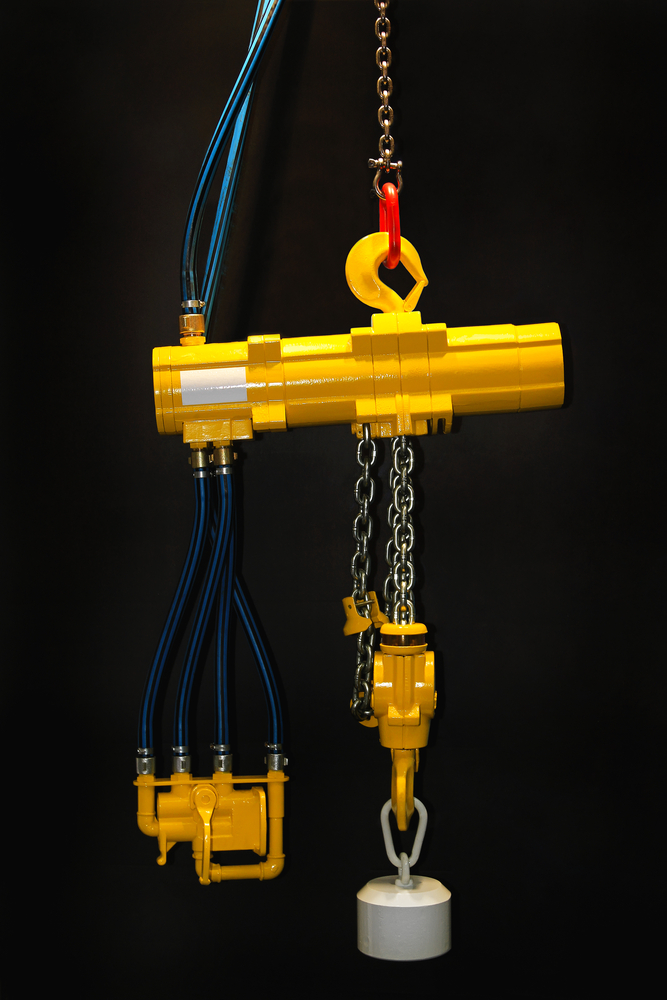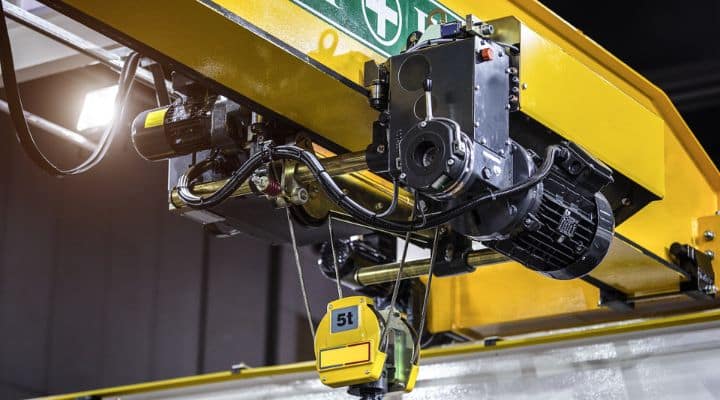Overhead hoists use pulleys, wire rope, and chains to achieve the leverage needed for lifting heavy objects with minimal effort. Overhead hoists can be electrically, pneumatically, or manually operated and will often be incorporated into cranes and other heavy machinery. Today, we will discuss the different types of overhead hoists available and how they are commonly used.
What Are the Different Types of Industrial Hoists?
Overhead hoists perform difficult tasks and must be selected based on the job they are to perform. Overhead hoists can be powered by electricity, air pressure, or manually powered by hand. Overhead hoists should be selected for their lifting capacity, mounting, reach, and lift, as these criteria will determine the functionality of the hoist.
Overhead hoists have been around since the 1800s, but really came into prominence in the early 20th century as electric versions became available. They were first introduced by Sampson Moore, an English engineer who designed and supplied the first electric overhead cranes. Electric hoists were much more capable of lifting heavier loads than the earlier manual versions. As powered hoists became the norm, pneumatic versions (air powered) also became popular in industrial settings. Below is a list of common overhead hoist systems and an overview of how they operate.
Chain Hoists
Chain hoists are among the most common hoists used by individuals. Chain hoists use a chain and pulley(s) to gain a mechanical advantage in lifting heavy weights. Chain hoists are often manually powered, like an overhead garage hoist designed to lift an engine from a car. Chain hoists can also be electrically powered or pneumatically powered, but the electric version is the most widely used. Chain hoists can come in a myriad of sizes, but chain hoists are typically used when the load to be lifted is under five tons.

Wire Rope Hoists
Wire rope hoists serve the same lifting function as a chain hoist, but wire rope hoists usually have a higher lifting capacity. Wire rope hoists wind the wire rope around a circular drum, which can often accommodate very long wire rope lengths. This storage capacity often allows a wire rope hoist to lift an object to greater heights than a chain hoist. Wire rope hoists are often electrically powered, but pneumatic versions are often used in industrial settings.

Manual Overhead Hoists
Also known as a chain block hoist, fairy hoist, or hand chain hoist, manual overhead hoists were among the first hoist designs. As with other overhead hoist designs, manual overhead hoists use a chain and pulley(s) to gain mechanical leverage over heavy objects. A very common, decades old tool, manual overhead hoists are often used to lift car engines and other relatively light objects. Manual overhead hoists use only mechanical leverage and hand power, so they require no additional connections to compressed air, nor electricity.
Electric Overhead Crane Hoists
Electric overhead crane hoists, as the name suggests, are powered by an electric motor. Electric crane hoists are often self-contained, and require only suspension and electrical power to operate. The simple design of electric overhead crane hoists often makes them preferable to pneumatic versions, as they are usually quick to set up. Electric overhead crane hoists can be permanently mounted such as in a factory setting, or they can simply hang from a hook.
Air Pneumatic Overhead Crane Hoists
Air (pneumatic) overhead crane hoists are likely the most common form of overhead hoist used in manufacturing. Pneumatic overhead crane hoists operate much the same way electric versions do, without the electric motor. Pneumatic overhead crane hoists are powered by compressed air pressure, which have a much longer duty cycle than electric versions. This feature alone makes pneumatic overhead crane hoists ideal for factory settings, since the hoist can theoretically run twenty four hours per day.
Hoist Suspension Systems
What is an Overhead Hoist Trolley?
Overhead hoist trolleys are a primary component of a crane responsible for moving objects horizontally. Overhead hoist trolleys are typically installed on the girder of a crane and used to position the hoist itself directly over an object to be lifted. Overhead hoist trolleys are generally available in three forms: low headroom, normal headroom, and double girder.

Low Headroom Overhead Hoist Trolley
Low Headroom Hoist Trolleys are designed for spaces with low ceilings, or headroom. Hoist trolleys can be quite large, especially when they are designed for heavy loads. Low headroom trolley hoists have a lower profile, making them very convenient in spaces where overhead space is at a premium. Low headroom hoist trolleys are commonly used as part of smaller, single girder cranes.
Normal Headroom Overhead Hoist Trolley
A normal headroom hoist trolley, as the name implies, is a standard sized hoist trolley and probably the most common. Normal headroom hoist trolleys are common to jib cranes and sometimes, monorails. Normal headroom trolleys are typical of jib cranes used for general purposes and likely can often be purchased off the shelf.
Double Girder Overhead Hoist Trolley
Double girder trolleys are designed for maximum duty and incorporate two girders as well as two end trucks. Most double girder trolleys are connected to the double girders via rails, which sit atop the girders to increase the available headroom. A double girder trolley also utilizes two end trucks, one on each side, which move the hoist and bridge girder(s) up and down the runway of the crane. Double girder trolleys are very common in industrial applications where additional headroom and lifting capacity are important.
What’s the Difference Between an Electric vs Pneumatic Chain Hoist?
Both electric chain hoists and pneumatic chain hoists offer a host of useful features and abilities, so what is the difference? Electric hoists became available in the late 1940’s as an alternative to manually powered hoists. Just a few years later, pneumatic chain hoists were introduced to address the limitations of electric chain hoists, such as duty cycles. Here we will look at both electric chain hoists and pneumatic chain hoists, and how they compare.
Electric Chain Hoist
Electric chain hoists are easy to use, widely available, and in most instances, less expensive than a similar pneumatic version. Electric chain hoists often have a large lifting capacity, are generally portable, and often require no more than an electrical outlet to operate. Electric chain hoists are also very reliable and require no additional connections, like air hoses. However, electric chain hoists generally have limited duty cycles, meaning they require a period of rest during every operation period.
Pneumatic Chain Hoist
Pneumatic chain hoists are commonly found in factories and production facilities due to their lifting capabilities and long duty cycles. The design of pneumatic chain hoists tends to be quite simple, keeps moving parts to a minimum. Pneumatic chain hoists can often provide greater lifting power than a similar electric version, as they tend to be very large machines. However, the design of pneumatic chain hoists often makes them less than ideal to transport.

What is a Rotary Hoist?
The term rotary hoist is often incorrectly interchanged with the term automotive hoist, two-post lift, or automotive lift. “Rotary hoist” actually refers to a company that makes automotive hoists and other lifting machinery. Rotary hoists refer to a vertical, two girder hoist usually found mounted to the floor of a garage. These rotary hoists can be either electrically or pneumatically powered, but the majority are pneumatic in design.
Rotary hoists employ electrical power to generate hydraulic pressure inside two cylinders, which provide the lifting force. These hydraulic cylinders are then connected through a series of wire ropes and pulleys to transfer this force to a girder under the vehicle. The wire ropes are also synchronized to avoid lifting one side faster than the other. Rotary hoists are generally available with sufficient lifting force to lift between 10,000 and 18,000 pounds.
How Do Electric Wire Rope Hoists Work?
Electric wire rope hoists are generally used when higher lifting capacities are required. Typically, electric wire rope hoists will be preferred when the lifting force required exceeds five tons, or 10,000 pounds. Electric wire rope hoists work by using electrical power to wind a very high tensile strength steel rope around a drum. Electric wire rope hoists accomplish this by using an electric motor to turn a gear, which turns the drum. The winding of the wire rope shortens or lengthens the distance from the electric wire rope hoist to the object.
What Criteria Should I Look For When Deciding to Install an Electric Chain Hoist or Wire Rope Hoist?
Electric Chain Hoist Criteria
The criteria used to select an overhead hoist should be based on the task it will perform. For example, electric chain hoists are often perfectly suited for lifting objects under 5000 pounds. Conversely, wire rope hoists are more commonly sized to projects exceeding 5000 pounds. Electric chain hoists also tend to be lighter than wire rope hoists, making them very popular among those needing portability and quick set up. Electric chain hoists also tend to have lifting height limitations because long chains take up space and can become very heavy.
Electric Chain Hoist Applications
As mentioned earlier, the primary use of the hoist will often determine which style should be used. Generally speaking, electric chain hoists are better suited for smaller projects that require less than five tons of lifting force. Electric chain hoists are typically more portable, making them ideal for lifting car engines, jibs, and gantries. Since electric chain hoists do not require air lines, often the operation will be quieter, neater, and cost less. In most instances, electric chain hoists are lighter and more compact in size than other electric hoists, making them very versatile.
Wire Rope Hoist Criteria
Wire rope hoists are often lug mounted or trolley mounted, which alleviates much of the weight concerns. Wire rope hoists are often supplied with a remote control, allowing the user to monitor the lifting action safely, enhancing overhead hoist safety. Wire rope hoists can often handle over 5000 pounds, which can sometimes be doubled by using pulleys and double winding the wire rope. Although this essentially halves the lifting distance available, it also makes wire rope hoists very versatile.
Electric Wire Rope Hoist Applications
In most instances, an electric wire rope hoist will be used when the lifting requirement exceeds five tons, or 10,000 pounds. Electric wire rope hoists can also be configured to employ one or more pulleys to essentially double the lifting force. Electric wire rope hoists are great for onsite job operations because they are often portable and require only electricity to operate.
Electric wire rope hoists also typically offer longer lifting heights. Because electric wire rope uses small diameter metal rope and a winding drum, much longer lifting distances are possible. This feature is particularly useful in industrial applications where cranes and gantries may be mounted very high. This ability can be mostly attributed to the small size of the wire rope in relation to the drum, which can often accommodate long lengths.
Hoist Suspension Systems
As described earlier, hoists are very versatile tools that can be permanently mounted or temporarily suspended above the load. In most applications, hoists are attached to a hook or trolley, depending on the application and location of the load. Hoists can be suspended from a hook, lug mounted, or an overhead hoist trolly.
Hook Suspension
Many manual and electric wire rope hoists come supplied with a heavy duty hook designed to support the weight of the hoist and its lifting capacity. Hook suspension of an overhead hoist allows the hoist to connect quickly and easily, making this version ideal for onsite applications. Hook suspension overhead hoists also help alleviate pinching and binding by pivoting on the hook, which permanently mounted overhead hoists can struggle to do.
Lug Mounted Suspension
Lug mounted overhead hoists are typically found in manufacturing and factory settings, and can be used in several ways. Lug mounted overhead hoists can be permanently mounted to a structure itself, bolted to a trolley, or most commonly, mounted to an overhead girder. Because lug mounted overhead hoists are usually stationary, they can be configured for nearly any manufacturing application. Lug mounted overhead hoists can be electrically powered, but most are powered pneumatically.
Need help choosing the right type crane for your project? Get a quote today.




